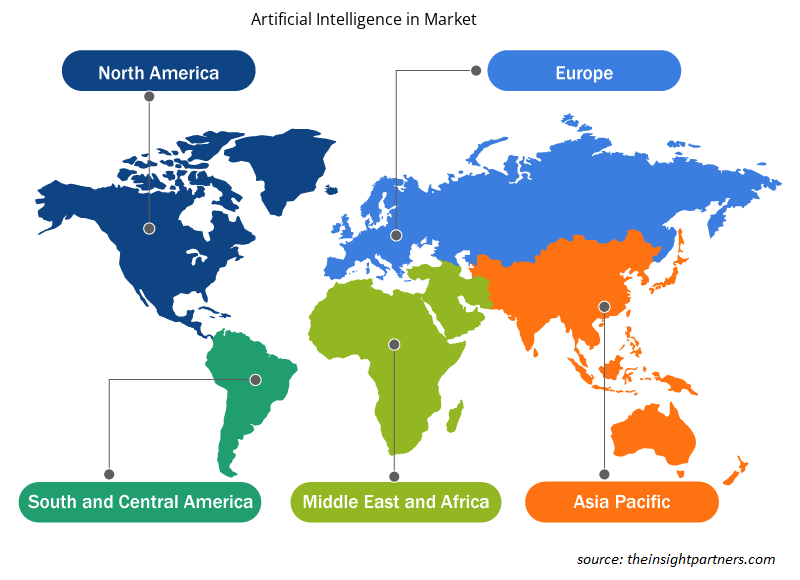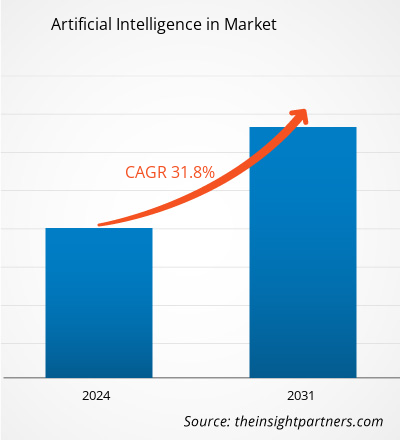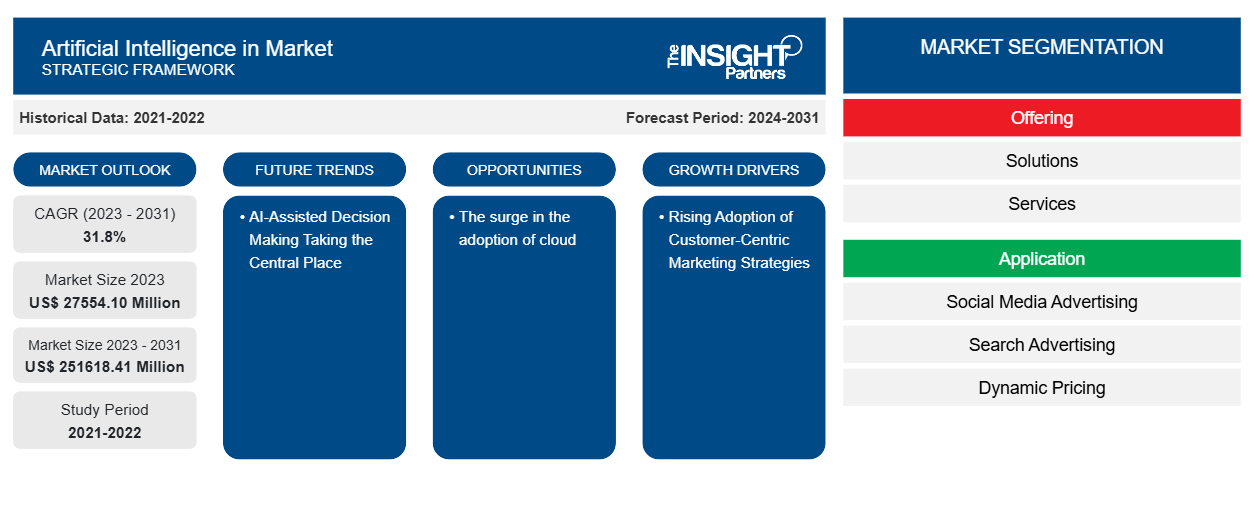Si prevede che la dimensione del mercato dell'intelligenza artificiale nel marketing raggiungerà i 251618,41 milioni di dollari entro il 2031, rispetto ai 27554,10 milioni di dollari del 2023. Si prevede che il mercato registrerà un CAGR del 31,8% nel periodo 2023-2031. È probabile che il processo decisionale assistito dall'intelligenza artificiale rimanga una tendenza chiave nel mercato.
Analisi di mercato dell'intelligenza artificiale nel marketing
Il crescente utilizzo delle piattaforme di social media per la pubblicità e la crescente adozione di strategie di marketing incentrate sul cliente sono tra i fattori che stimolano la crescita dell'intelligenza artificiale nel mercato del marketing. Tuttavia, la scarsità di personale esperto in conoscenza dell'IA ostacola la crescita del mercato. Inoltre, l'impennata nell'adozione di applicazioni e servizi basati su cloud crea notevoli opportunità per l'intelligenza artificiale nei player del mercato del marketing.
Panoramica del mercato dell'intelligenza artificiale nel marketing
Le tecnologie di intelligenza artificiale (IA) vengono utilizzate nel marketing per aiutare il processo decisionale automatizzato basato sulla raccolta di dati, analisi e osservazioni extra di pubblico o trend economici che potrebbero influenzare le campagne di marketing. L'IA viene spesso utilizzata nelle campagne di marketing digitale quando l'efficienza è fondamentale. Quando la velocità è fondamentale negli sforzi di marketing digitale, viene spesso impiegata l'IA generativa . Le soluzioni di marketing basate sull'IA imparano come interagire con i clienti in modo più efficace utilizzando dati e profili dei clienti. Quindi inviano messaggi personalizzati al momento opportuno senza l'aiuto del personale del team di marketing, garantendo una produttività ottimale. L'IA generativa viene utilizzata da un gran numero di moderni esperti di marketing digitale per supportare i propri team o svolgere attività più tattiche che richiedono meno delicatezza umana.
Personalizza questo report in base alle tue esigenze
Riceverai la personalizzazione gratuita di qualsiasi report, comprese parti di questo report, o analisi a livello nazionale, pacchetto dati Excel, oltre a usufruire di grandi offerte e sconti per start-up e università
-
Scopri le principali tendenze di mercato in questo rapporto.Questo campione GRATUITO includerà analisi di dati che spaziano dalle tendenze di mercato alle stime e alle previsioni.
Intelligenza artificiale nel marketing Driver di mercato e opportunità
Crescente adozione di strategie di marketing incentrate sul cliente
Per prosperare nel mercato globale fortemente competitivo, molte aziende, indipendentemente dal settore a cui appartengono, si stanno concentrando sulla creazione di relazioni a lungo termine e reciprocamente vantaggiose con i propri clienti. L'attenzione delle tattiche e delle azioni di coinvolgimento dei clienti è cambiata negli ultimi anni, passando da essere principalmente incentrate sul prodotto a essere più incentrate sul cliente. Adottando un approccio incentrato sul cliente, le aziende possono anticipare e servire meglio le esigenze dei propri clienti in ogni momento. Le aziende che sono passate efficacemente al coinvolgimento incentrato sul cliente hanno dimostrato di avere un vantaggio competitivo significativo e di aver aumentato le vendite e i ricavi. Più di un terzo delle organizzazioni Fortune 500, secondo l'Harvard Business Review, si sono ristrutturate pensando al cliente, utilizzando percorsi, preferenze e segmentazione come principi guida. Tuttavia, molte aziende note hanno effettivamente abbracciato la centralità del cliente negli ultimi anni. Le aziende più popolari incentrate sul cliente negli Stati Uniti includono USAA, Tumi e American Express. Compagnie aeree come Singapore Airlines, Air Innovative Zealand ed Emirates stanno abbandonando i loro metodi tradizionali a favore di forme pubblicitarie innovative.
L'impennata nell'adozione del cloud
Per gli utenti del cloud, l'intelligenza artificiale (IA) si è evoluta in uno strumento multifunzionale per la gestione dei dati, la sicurezza, l'analisi dei dati e il processo decisionale strategico. La sua capacità acquisita di utilizzare l'apprendimento automatico e produrre interpretazioni oggettive di approfondimenti basati sui dati aumenta l'efficienza di queste procedure e fa risparmiare all'azienda una notevole quantità di denaro. L'utilizzo di software di IA basato su algoritmi di apprendimento automatico in ambienti cloud consente alle aziende di fornire agli utenti e ai consumatori esperienze connesse e intuitive. Pertanto, l'aumento dell'adozione del cloud sta creando varie opportunità per il mercato.
Analisi della segmentazione del rapporto di mercato sull'intelligenza artificiale nel marketing
I segmenti chiave che hanno contribuito all'adozione dell'intelligenza artificiale nell'analisi del mercato del marketing sono l'offerta, l'applicazione e il settore di utilizzo finale.
- In base all'offerta, l'intelligenza artificiale nel mercato del marketing è divisa in soluzioni e servizi. Il segmento delle soluzioni ha detenuto una quota di mercato maggiore nel 2023.
- Per applicazione, il mercato è segmentato in pubblicità sui social media, pubblicità di ricerca, prezzi dinamici, assistente virtuale, cura dei contenuti, automazione delle vendite e del marketing, piattaforma di analisi e altri. Il segmento della pubblicità sui social media ha detenuto una quota di mercato maggiore nel 2023.
In base al settore di utilizzo finale, il mercato è segmentato in BFSI, vendita al dettaglio, beni di consumo, media e intrattenimento e altri.
Analisi della quota di mercato dell'intelligenza artificiale nel marketing per area geografica
L'ambito geografico del rapporto di mercato sull'intelligenza artificiale nel marketing è suddiviso principalmente in cinque regioni: Nord America, Asia Pacifico, Europa, Medio Oriente e Africa, e Sud e Centro America.
Il Nord America domina l'intelligenza artificiale nel mercato del marketing. I principali attori del mercato dell'intelligenza artificiale nel marketing, come Adobe, Amazon Web Services, IBM, Salesforce e Accenture, hanno adottato varie strategie organiche e inorganiche per migliorare i loro ricavi e la loro posizione di mercato. Ad esempio, Appier ha lanciato ARTIFICIAL INTELLIGENCEXPERT, un assistente pubblicitario basato su app basato su INTELLIGENZA ARTIFICIALE che aiuta i marketer a scalare facilmente le loro prestazioni di campagne di vendita tramite campArtificial Intelligencegns nel gennaio 2021. Pertanto, il mercato sta crescendo nella regione.
Ambito del rapporto di mercato sull'intelligenza artificiale nel marketing
Intelligenza artificiale nel mercato regionale Insights
Le tendenze regionali e i fattori che influenzano l'intelligenza artificiale nel mercato durante il periodo di previsione sono stati ampiamente spiegati dagli analisti di Insight Partners. Questa sezione discute anche i segmenti e la geografia dell'intelligenza artificiale nel mercato in Nord America, Europa, Asia Pacifico, Medio Oriente e Africa e America meridionale e centrale.

- Ottieni i dati specifici regionali per l'intelligenza artificiale nel mercato
Intelligenza artificiale nell'ambito del rapporto di mercato
| Attributo del report | Dettagli |
|---|---|
| Dimensioni del mercato nel 2023 | 27554,10 milioni di dollari USA |
| Dimensioni del mercato entro il 2031 | 251618,41 milioni di dollari USA |
| CAGR globale (2023-2031) | 31,8% |
| Dati storici | 2021-2022 |
| Periodo di previsione | 2024-2031 |
| Segmenti coperti |
Offrendo
|
| Regioni e Paesi coperti |
America del Nord
|
| Leader di mercato e profili aziendali chiave |
|
Intelligenza artificiale nella densità degli attori del mercato: comprendere il suo impatto sulle dinamiche aziendali
Il mercato dell'intelligenza artificiale nel mercato sta crescendo rapidamente, spinto dalla crescente domanda degli utenti finali dovuta a fattori quali l'evoluzione delle preferenze dei consumatori, i progressi tecnologici e una maggiore consapevolezza dei vantaggi del prodotto. Con l'aumento della domanda, le aziende stanno ampliando le loro offerte, innovando per soddisfare le esigenze dei consumatori e capitalizzando sulle tendenze emergenti, il che alimenta ulteriormente la crescita del mercato.
La densità degli operatori di mercato si riferisce alla distribuzione di aziende o società che operano in un particolare mercato o settore. Indica quanti concorrenti (operatori di mercato) sono presenti in un dato spazio di mercato in relazione alle sue dimensioni o al valore di mercato totale.
Le principali aziende che operano nel mercato dell'intelligenza artificiale sono:
- Affettiva
- Società a responsabilità limitata
- Bidalgo
- Novantas (Amplero) Inc.
- Scala cognitiva
- Istituto SAS Inc.
Disclaimer : le aziende elencate sopra non sono classificate secondo un ordine particolare.

- Ottieni la panoramica dei principali attori chiave dell'intelligenza artificiale nel mercato
Intelligenza artificiale nel marketing: notizie di mercato e sviluppi recenti
L'intelligenza artificiale nel mercato del marketing viene valutata raccogliendo dati qualitativi e quantitativi dopo la ricerca primaria e secondaria, che include importanti pubblicazioni aziendali, dati associativi e database. Di seguito sono elencati alcuni degli sviluppi nell'intelligenza artificiale nel mercato del marketing:
- Clarivate Plc, un fornitore leader a livello mondiale di intelligence trasformativa, ha lanciato oggi la prima versione disponibile al pubblico di Trademark Watch Analyzer in occasione dell'International Trademark Association Annual Meeting del 2024. In quanto soluzione di protezione dei marchi di nuova generazione potenziata dall'intelligenza artificiale (IA) e dalla tecnologia cloud, questa soluzione combina i dati globali Clarivate sui marchi e sulla giurisprudenza, l'esperienza IP interna e la tecnologia IA all'avanguardia. Fornirà risposte più rapide e accurate a domande aziendali critiche automatizzando le attività chiave di monitoraggio dei marchi e assegnando in modo intelligente la priorità ai set di risultati. (Fonte: Signify, comunicato stampa, maggio 2024)
- L'azienda di customer engagement omnicanale Emarsys, che fa parte di SAP dal 2020, ha annunciato il lancio di AI Product Finder, una nuova soluzione per raccomandazioni di prodotti ed esperienze personalizzate per i clienti. La mossa risponde all'interesse dei consumatori per l'intelligenza artificiale per il commercio, con i dati di Emarsys che mostrano che il 64% dei consumatori ritiene che l'intelligenza artificiale abbia migliorato le proprie esperienze di commercio. (Fonte: Tungsram Group, comunicato stampa, aprile 2024)
Copertura e risultati del rapporto di mercato sull'intelligenza artificiale nel marketing
Il rapporto "Dimensioni e previsioni del mercato dell'intelligenza artificiale nel marketing (2021-2031)" fornisce un'analisi dettagliata del mercato che copre le seguenti aree:
- Dimensioni e previsioni del mercato dell'intelligenza artificiale nel marketing a livello globale, regionale e nazionale per tutti i segmenti di mercato chiave coperti dall'ambito
- Intelligenza artificiale nelle tendenze del mercato del marketing, nonché dinamiche di mercato come driver, vincoli e opportunità chiave
- Analisi dettagliata delle cinque forze PEST/Porter e SWOT
- analisi di mercato dell'intelligenza artificiale nel marketing che copre le principali tendenze di mercato, il quadro globale e regionale, i principali attori, le normative e i recenti sviluppi del mercato
- Analisi del panorama industriale e della concorrenza che copre la concentrazione del mercato, l'analisi della mappa di calore, i principali attori e gli sviluppi recenti per l'intelligenza artificiale nel mercato del marketing
- Profili aziendali dettagliati
- Analisi storica (2 anni), anno base, previsione (7 anni) con CAGR
- Analisi PEST e SWOT
- Valore/volume delle dimensioni del mercato - Globale, Regionale, Nazionale
- Industria e panorama competitivo
- Set di dati Excel
Report recenti
Testimonianze
Motivo dell'acquisto
- Processo decisionale informato
- Comprensione delle dinamiche di mercato
- Analisi competitiva
- Analisi dei clienti
- Previsioni di mercato
- Mitigazione del rischio
- Pianificazione strategica
- Giustificazione degli investimenti
- Identificazione dei mercati emergenti
- Miglioramento delle strategie di marketing
- Aumento dell'efficienza operativa
- Allineamento alle tendenze normative























 Ottieni un campione gratuito per - Intelligenza artificiale nel mercato del marketing
Ottieni un campione gratuito per - Intelligenza artificiale nel mercato del marketing